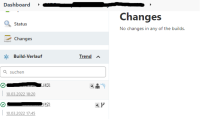-
Type:
Bug
-
Resolution: Unresolved
-
Priority:
Minor
-
Component/s: git-client-plugin, github-plugin
-
Environment:Jenkins 2.319.3
Git Plugin 4.10.3
Git Client Plugin 3.11.0
GitHub 1.34.2
We are trying to avoid build steps as much as possible, for example skipping some of then when a build was triggered by a upstream project but did not have any changes on its own or a commit message contained a specified string (aka [skip ci]).
Therefor we heavily rely on the currentBuild.changeSets.
Unfortunatly we recently discovered that builds are triggered when a force push is used (which is good) to a repository, but the changes are empty (thats not expected). This can also be seen in the corresponding UI.

There might be other constellations where it does not work but this is one we could reproduce.
